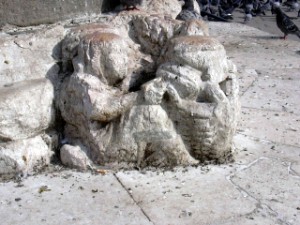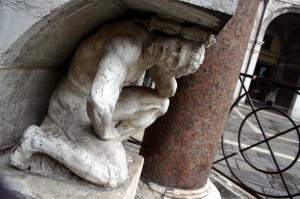The “Oracles” in Venice.
As the witty of Rome, in Venice there were statues of the “oracles.” One of the chronicles and the following:
( Antonio Rioba’s chronicle.I know that someone has spoken badly about me, but I do not have anything to hide. Yes! is true!, with Maroc and the hunchback, we tattled on everything that passed through Venice, without hard feelings. And onestly talking ;gossips are not only for the women .)
In the past in Rome there was the comedy of the witty, a series of six statues to which the pranksters hung satirical cards and leaflets.
As it was forbidden by law in Veneto to satirize exaggerated, many revelers wrote poems and stories against the nobility (which was the only one to hold power) and putting up their package signing himself with the names of the statues . The faithful friends who lived nearby would collect the sheets and they were going to spread the stories.Many of them wrote to the three statues like a real mail and also received the answers.
The statues, which are visible from the camp of the Moors, represent the many famous  three brothers Rioba, Sandi and Afani. The only one to have his name engraved (in luggage on his shoulders) is Rioba, whose head appears to have been detached from the body, perhaps of the collapse as a result of the bombing, and, falling has destroyed the nose (that can be admired intact in some photographs of the late nineteenth century) was replaced with a grotesque iron nose ,which disfigures the face shamefully. (A legend says that rubbing it you would have had luck.)
three brothers Rioba, Sandi and Afani. The only one to have his name engraved (in luggage on his shoulders) is Rioba, whose head appears to have been detached from the body, perhaps of the collapse as a result of the bombing, and, falling has destroyed the nose (that can be admired intact in some photographs of the late nineteenth century) was replaced with a grotesque iron nose ,which disfigures the face shamefully. (A legend says that rubbing it you would have had luck.)
Maroco de Pipone (Morocco Melon)
” Maroco de pipone” has to do with the sale of melons, then probably his job was greengrocer and therefore spends his days  behind a basket where he exposed the merchandise.That statue, like those of Pasquino and Morforio in Rome , is one of those small figures placed at the steps of the ornate columns in Piazzetta S. Marco, which holds a basket of melons.
behind a basket where he exposed the merchandise.That statue, like those of Pasquino and Morforio in Rome , is one of those small figures placed at the steps of the ornate columns in Piazzetta S. Marco, which holds a basket of melons.
To see “el gobo de Rialto ” you have to go to Campo San Giacomo de Rialto, in the Rialto market, which is reached from the bridge of Rialto along a short stretch of the wrinkle of Oresi. The trunk of the column have the same quality of red granite stone like that on the Piazza San Marco brought from the city of Acre as war booty after the victory over Genoa and flanked by a ladder made of Istrian stone; beneath is a male figure bent by the weight of the above , called the Hunchback of Rialto , (sculpture by Pietro da Salò year 1541 )
During the Middle Ages, however, the hunchback was the end of the track to which the  thieves were forced to walk barefoot from San Marco to Rialto while two rows of the crowd whipped and insulted them . Generally arrived exhausted embraced him and kissed him as if he were their savior .
thieves were forced to walk barefoot from San Marco to Rialto while two rows of the crowd whipped and insulted them . Generally arrived exhausted embraced him and kissed him as if he were their savior .
Signor Antonio Rioba , so called by the people, was for a long time the ” Pasquino of Venice,”( The name of the the speaking statue of Rome) in whose name were spreading bitter reproaches and bitter raillery . An imaginative character named Morocco , is intertwined with that of ( el gobo ) the hunchback de Rialto and indirectly with the de “Zior Antonio Rioba and the two (or three) brothers” . They formed a formidable trio of great talkers , who competed with Pasquino and Morforio of Rome, in mock and make fun of any person, by means of cards that were pinned on their bases at night .
( The History of Venice in private life, TRIESTE , 1973 vol . II, p. 258 ) describes as
” Pamphlets and caricatures anonymous , is also putting up that stone , from which the laws were published ,and which is supported by a curved statue , called the Hunchback of Rialto . Among the statue of Rome and that of Venice ran a sort of satirical correspondence , and behind the name of the Hunchback hid many writers of lampoons against the people, the behavior , the clergy and even the state . ”
other items http://dipoco.altervista.org/
visit my website http://ginocosta.altervista.org/
